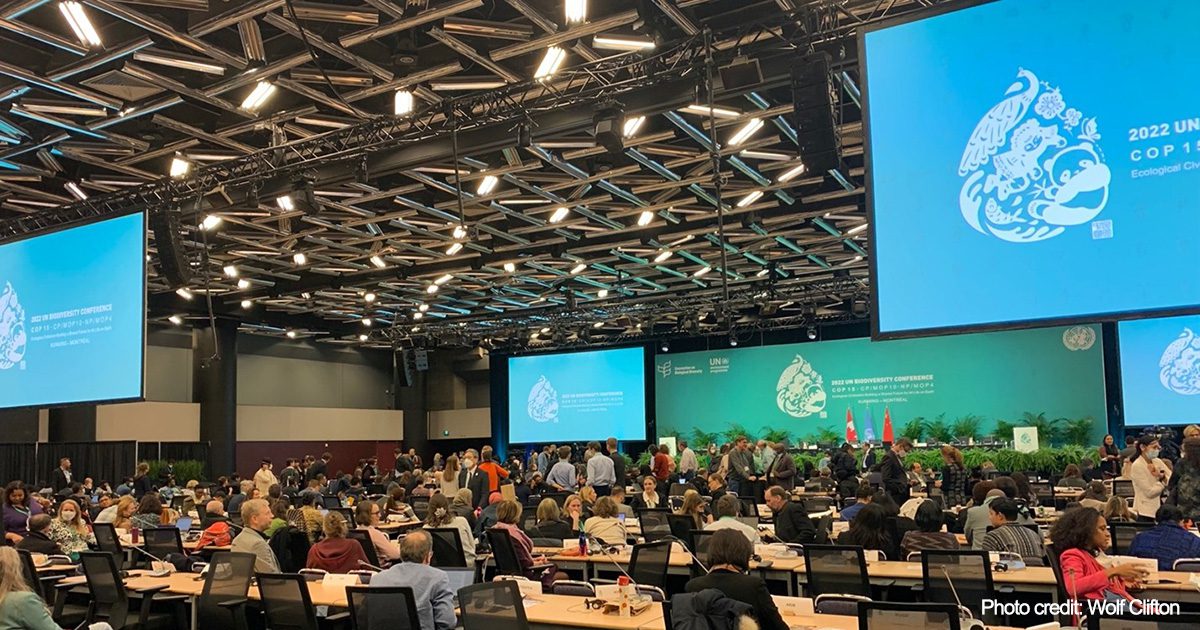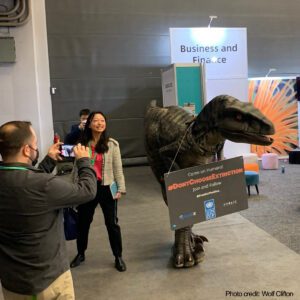
Jan 18, 2023 A Participant’s Reflections on the Montreal Biodiversity (COP15) Conference
As the director of Animal People, I had the opportunity to attend the second part of the U.N. Biodiversity Conference – also known as the 15th Conference of Parties to the Convention on Biological Diversity, or COP 15. COP 15 was convened in Montreal in December 2022 to establish a new global framework to preserve biodiversity over the coming decade and longer. While the Convention on Biological Diversity (CBD) was established at the same time as the U.N. Framework Convention on Climate Change (UNFCCC), the CBD has languished in obscurity compared to the climate treaty. Only a single world leader, prime minister Justin Trudeau of Canada, which co-hosted the Conference with China, attended COP 15.
The lack of global attention is unfortunate. Biodiversity loss is a planetary crisis in its own right and contributes significantly to climate change and vice versa. The two crises share common drivers that add to the deterioration of our planet. For example, clearing land to support agriculture, especially in the tropics, is harmful to both climate and biodiversity. The two crises also share common solutions, including restoring habitats whose diverse fauna and flora naturally sequester carbon. Despite the urgent need for global action on biodiversity, COP 15 suffered from a series of delays. The original meeting was scheduled for 2020 in Kunming, China but was postponed due to the COVID pandemic. The Conference was split into two parts, the first organized virtually in Kunming in October 2021 and the second in Montreal a year later. The Conference in Montreal opened with numerous outstanding disagreements over the proposed Framework text.
Animal People attended COP 15 as an Observer at the Convention. The contingent of animal welfare organizations also included Africa Network for Animal Welfare (ANAW), Born Free, Four Paws, International Animal Rescue (IAR), International Fund for Animal Welfare (IFAW), World Animal Protection (WAP), and World Federation for Animals (WFA). WFA and Born Free primarily led the agenda with priority points for inclusion in the Post-2020 Biodiversity Framework. These points included the recognition of the One Health framework (featuring the connections between human, animal, and environmental health), an invasive species strategy that emphasized prevention rather than subsequent eradication of invasives, and the deletion of proposed language that endorsed trophy hunting as a conservation practice.
Every target of the draft CBD framework is related in some way to animal welfare – from land clearing and harmful subsidies linked to animal agriculture to “sustainable use” of wild animals for everything from subsistence hunting to commercial trade in fur, skins, medicinal ingredients, and exotic pets. Other stakeholder groups in attendance included corporate representatives, scientists, faith and cultural leaders, artists and entertainers, and journalists. While Animal People supported efforts to lobby negotiators and influence the framework text, we also sought to contribute to the “culture” of COP 15, raising awareness of animal welfare among various stakeholders. To this end, we distributed pamphlets, arranged interviews with reporters, and organized a small side event in collaboration with the Faith and Biodiversity U.N. Coordination Group.
Animal welfare issues were seldom broached explicitly during the official negotiations. Conceptual discussions of science or strategy, let alone ethics, were limited, generally taking a backseat to political and economic considerations. Multiple events focused on the One Health framework and the dangers of the wildlife trade as a pathway for zoonotic diseases. WAP hosted a well-attended side event on animal welfare campaigns and biodiversity in Canada, including discussions of the pending Jane Goodall Act and collaborations with First Nations organizations. At a day-long series of talks organized by Indigenous Peoples and Local Communities (IPLCs), Chief Doug Neasloss spoke proudly of how the Kitasoo, Xai’xais, and other First Nations in British Columbia had banned trophy hunting of bears on their lands. During an event on food system reform, Dr. Tony Weis of the University of Western Ontario highlighted the negative impacts of industrial livestock farming on biodiversity and the “violent narrowing of animal life” in farms and slaughterhouses. Costa Rica’s official exhibit included literature and signage on the cruelty of wild animal selfies.
 Not everything was positive at COP 15. Despite sporadic mentions of the need to reduce global meat consumption, vegetarian food options were limited, and vegan ones were almost non-existent. Yet overall, compared to other U.N. environmental events I have attended, most of the conference participants I engaged were already sensitized to non-human animal issues. However, raising the profile of animal welfare will require much greater participation by advocates. There was limited activism overall compared to major climate conferences. A few small demonstrations inside the convention center included protests by Indigenous rights activists and a visit by someone wearing an animatronic dinosaur suit to protest extinction. A small but angry crowd of anti-capitalist protesters amassed outdoors on the evening of the final day to hurl profanities and water balloons, too late to influence any negotiations. Had more activists of various causes shown up throughout COP 15, it might have resulted in a slightly more ambitious final product, fostering greater accountability among negotiators.
Not everything was positive at COP 15. Despite sporadic mentions of the need to reduce global meat consumption, vegetarian food options were limited, and vegan ones were almost non-existent. Yet overall, compared to other U.N. environmental events I have attended, most of the conference participants I engaged were already sensitized to non-human animal issues. However, raising the profile of animal welfare will require much greater participation by advocates. There was limited activism overall compared to major climate conferences. A few small demonstrations inside the convention center included protests by Indigenous rights activists and a visit by someone wearing an animatronic dinosaur suit to protest extinction. A small but angry crowd of anti-capitalist protesters amassed outdoors on the evening of the final day to hurl profanities and water balloons, too late to influence any negotiations. Had more activists of various causes shown up throughout COP 15, it might have resulted in a slightly more ambitious final product, fostering greater accountability among negotiators.
The Framework has been hailed for its relatively progressive text on human rights, especially its support of Indigenous peoples, women, and youth. Still, such victories would not have been achieved had spokespersons for human rights causes not been active at every step of the negotiation process. Advocates for animals would do well to learn from their examples.
Despite the small number of animal advocates in attendance, the final draft of the Post-2020 Biodiversity Framework did include some significant wins. The ambitious 30 by 30 plan – to legally protect 30% of the Earth’s land and water surface by 2030 – was successfully adopted, recognizing the need for interconnected, ecologically diverse spaces that genuinely meet the needs of wildlife and Nature. The proposed reference to trophy hunting and its rebranding as “sustainable conservation hunting” was rejected. While “sustainable use” is promoted, it is qualified by a proviso that such use should be of demonstrable value to conservation. The invasive species language emphasizes the prevention of introductions as a priority action, and its supplementary conference room paper identifies the exotic pet industry as the source of many invasions. One Health is acknowledged, and the wildlife trade is specified explicitly as a source of pathogen spillover. The Framework also recognizes “diverse value systems” and the “rights of nature,” potentially setting a precedent for recognizing the intrinsic value of animals’ lives. However, the proposed language to encourage dietary shifts was removed, and the wildlife meat trade was essentially endorsed in a conference room paper. Also unfortunate is a line encouraging “sustainable intensification” of food systems, which the livestock industry could exploit as a license to “greenwash” factory farming.
The Post-2020 Biodiversity Framework will govern global biodiversity policy for the next eight years and shape future agreements from 2030 onward. COP16 will be held in Türkiye in late 2024. Animal and environmental protection organizations should plan to attend. Registering as an Observer to the CBD is relatively easy by U.N. standards if done well in advance, and sufficient delegate slots are allotted to accredited organizations to share with other groups. In the meantime, the CBD Secretariat’s Action Agenda allows advocates to sign on as partners in preserving biodiversity.


